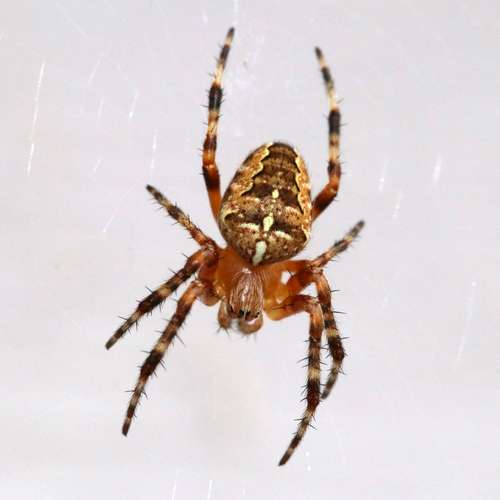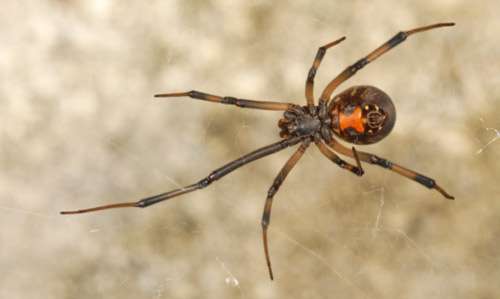
Argiope aurantia, a species of spider, is also known as the Steeler spider, maize spider, McKinley spider, zigzag spider, writing spider, black and yellow argiope, golden garden spider, black and yellow garden spider. The contiguous United States, Hawaii, southern Canada, Mexico, and Central America all share this condition. It has striking black and yellow stripes on the abdomen, while the cephalothorax is mainly white. The scientific name, which means “gilded silver-face” (the genus name Argiope meaning “silver-face”, while the specific epithet aurantia means “gilded”). Males’ body lengths range from 5 to 9 mm (0.2 to 0.35 in); that of females is 19 to 28 mm. These spiders may bite if startled or harassed, but their venom is not harmful to non-allergic people and has a stinging power akin to that of a bumblebee.
Geographical Distribution
From southern Canada to the lower 48 states, Mexico, and Central America as far south as Costa Rica, these spiders can be found.
Habitat
This species enjoys sunny spots with tall plants, flowers, and bushes. Although it is not frequently found in the Rocky Mountains or the Canadian Great Basin, it can be found in many different types of habitats.
Description of the body
Size
The females of this species grow to substantially bigger sizes than the males, as is true of many spider species. Male adult body length barely reaches 5 to 9 mm (1/4 to 3/8 in.) while adult female body length ranges from 19 to 28 mm (3/4 to 1 1/8 in.).
Abdomen
The glossy, egg-shaped abdomen of both sexes displays eye-catching yellow or orange markings against a black backdrop.
Cephalothorax
Short, silvery hairs cover the cephalothorax, the forward portion of the body. The majority of the legs are black, with red or yellow patches close to the body.
Claws
This species, like others in the family Araneidae, has three claws per foot, one more than the majority of spiders. Orb weavers to manage the strands when spinning use this third claw. Like most orb-weaving spiders, A. aurantia has a poisonous bite that immobilizes prey that gets caught in its web. However, not all spiders do.

Reproduction
Males of this species abandon their webs when they reach adulthood and go in quest of females. When they locate them, they wait on the border of her web while occasionally weaving a little web of their own. The number of times or the number of partners that men or females mate with is unknown. Each female most likely mates with one or more males.
Each female produces one or more (occasionally four, typically fewer) brown, papery egg sacs following the mating. They have a fairly rounded form, have a diameter of up to 25 mm, and hold 300–1400 eggs each. In close proximity to her supine position at the centre, she fastens her egg sacs to one side of her web.
Feeding Habits
The black-and-yellow argiope spider is a carnivore like all spiders. To catch tiny flying insects like aphids, flies, grasshoppers, and Hymenoptera, they spin an orb web (wasps and bees). A female may consume prey that is up to 200% of her own size and has a diameter of 47mm.
The web can cover up to two feet. While waiting for prey, the spider hangs, head bowed, in the centre of its web. She frequently holds her legs in pairs to give the impression that there are only four of them. When food settles in the web, a nonstick thread connecting the spider to the centre may tremble, allowing it to sometimes hide in a neighboring leaf or grass stem.
Economic Importance for Humans
Positive
The biochemistry of this spider’s venom and web-making process is a topic of research. These studies’ findings might be helpful for the fields of neurophysiology and materials science.
Keeping as Pet
- Buy a terrarium or a cage. A small spider cage or terrarium can be purchased from your neighborhood pet shop or online because spiders don’t require a lot of space. To prevent your spider from escaping, make sure the container has a tight-fitting lid. At the pet store, you may find many extra-small containers that are around 4 by 7 inches (10 cm 18 cm) in size. In order to allow your garden spider to breathe fresh air, the lid should also have some ventilation.
- Fill the cage with soil, leaves, and wood. The bottom of the cage should have about 1 inch (2.5 cm) of garden soil spread across it. From your yard, collect sticks, branches, and leaves. Distribute them throughout the cage. This will provide the spider with materials to make a web from as well as hiding or climbing spots. Use grass that hasn’t been treated with insecticides or pesticides.
- In the cage, place the spider. Once the cage is ready and a garden spider has been located, place a tiny plastic container in front of the spider’s web. To trap the spider, bring the lid toward the container while holding it directly behind the spider. The spider should then be let loose into its prepared habitat. If you accidentally put some spider web in the jar, it won’t matter.
- Give your spider some water. Your garden spider just needs a modest amount of water in its cage because the majority of garden spiders are small. Turn the top of a plastic bottle cap upside down. It will serve as a water dish within the cage when it is filled with water. If you’d rather, you can add water to a spray bottle and mist the spider’s web once daily. Make sure the cage’s interior doesn’t become wet; otherwise, mold might grow there.
- To feed the garden spider, collect insects. To catch flying insects like flies, wasps, and butterflies, use a net. These are the pests that your garden spider often captures and consumes in its web. If you’d prefer to buy insects, go to your neighborhood pet store and get some crickets. Consider that the spider might favor flying insects.
Table





